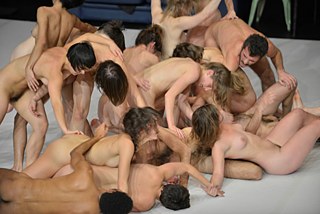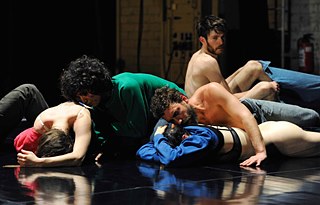Iconography of the body
Nudity and Nearness

Naked bodies have become a more or less customary sight, also on stage. Yet when it no longer involves the Vice Squad or provokes accusations of pornography, what can a naked body actually signify? Contemporary dance is exploring this issue and offers examples for the debate surrounding the unclothed body and its effect.
The ideal body image in the so-called western cultural sphere is naturally normative. Thus the allegedly ubiquitous representation of naked bodies in advertising, art and media often becomes a fiction of nakedness. Real, existing body shapes – fat, stocky, frail, old – are placed under a taboo. This is also true of dance. The great majority of stage events is populated by young and trained performers. However, interest has shifted. Since nakedness is no longer automatically perceived as scandalous, the question arises as to what a bare body actually signifies. For while it may have become a customary sight, nudity has not yet become really commonplace.
Function value of nakedness
The choreographer and dancer Mette Ingvartsen has recently produced several works that trace the societal and aesthetic function value of nakedness. In her group piece 7 Pleasures we see 12 dancers emerge from the audience, strip off their clothes and move on stage through a figurative course, sometimes ecstatic, sometimes meditative, but always as a collective. The individual body merges into the moving sculpture of the entirety, has its solo part at some point and then disappears again into the generality. Yet 7 Pleasures is not about nudity as an exposure of the intimate. In fact, the unclothed body appears more like a mask, as a subtle costuming for that which actually defines the body: a bundle out of desire, individuality and social interaction. There is nothing pornographic in this curious experimental tableau. The bodies of the performers blend completely into their activity; their nakedness is not tantalizing, it is a kind of self-obliviousness. This marks the great difference to pornography. The centuries-old fear of nakedness is presumably in actual fact the fear of pornography, i.e. the externalization of the lust experienced in the showpiece. Nowadays, the appearance of the body in its own skin or in a civilisation-related covering is more fiercely contested than ever – see, for example, the debates about veiling the entire body, headscarves and beards.Nakedness is transient
Ingvartsen refers to this connection between nagedness and pornograpy in her soloistic lecture performance 69 Positions (2014). In front of reproductions of some illustrations to de Sade’s scandalous novel Justine or the Misfortunes of Virtue, it becomes quite clear with what exuberance the imagination seizes possession of the body as an instrument of lust. Ingvartsen consigns this early objectification to the ranks of 20th-century performance history, which with Living Theater, the US-Amarican playwright Richard Foreman or Carolee Schneeman, also from the US, fought a spirited battle against the ban on nudity.But with what success? If exhibited nakedness defends itself in the name of art against pornographic usurpation, the question remains as to other versions. Schneeman’s performance Meat Joy from 1964 dealt with the Vietnam War, women’s rights and Puritanism in equal measure. A revival of this production, suggested by Ingvartsen, was vetoed by Schneeman – also with reference to the age of those who participated at the time. Which takes us once again to the norms. Particularly instructive here is the fact that the body never stays the same. Whether in lust, in performance or in ageing – nakedness is always transient, perhaps deceptive, but in any case fragile. It may not suffice as a weapon, no matter in what battle it is to be used.
Such stuff as we are made of (2000) by Lia Rodrigues was an early piece by the Brazilian choreographer, who regards her artistic work fundamentally as activism. The naked dancers performed in the midst of the audience, which was then obliged to constantly examine its own sense of shame. How much distance to keep? Where to look? What to be mindful of? Rodrigues’ production of Pindorama from 2013 also focuses on the motif of nakedness and nearness. The unclothed bodies become a metaphor of mutability, the body a spatial apparition that can be observed and interpreted in diverse ways.
Sheer coincidence
